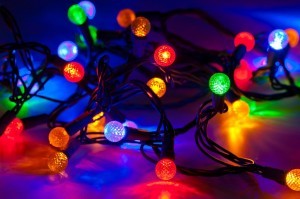The Christmas holiday season is a time of year that we should be spending with family and spreading joy to all of our loved ones. During this time of year it may be easy to overlook some of the fire hazards that come along with the decorations of the season.
The NFPA estimates an average of 230 American homes are damaged each year by fires caused by ignited Christmas trees. Another 150 home structure fires are caused by line voltage decorative lights. Together these fires cause an average of 15 deaths, 38 injuries and $26.7 million dollars in property damage each year! These sobering figures cannot be ignored and safety precautions need to be taken to help ensure you and your loved ones have a safe and enjoyable holiday season without the fire alarm going off.
Here are some great tips we would like to pass your way to help you keep your holiday fire free.
- When choosing a tree be sure to pick one that is a fresh as possible. Look to see your tree has green, semi-pliable needles. Dry needles have a much higher possibility of catching fire. Cutting down the tree yourself is the best way to ensure its freshness.
- If you have an artificial tree be sure it is labeled Fire Retardant by the manufacturer. While having a real tree might bring a sense of holiday authenticity, the simple fact of the matter is that artificial trees are much less likely to catch fire.
- Before putting your real tree in a stand be sure to cut off at least 2 to 3 inches of the base to expose some fresh wood. This will allow the tree to stay moist and prevent dryin gout. Be sure to check the water level of the tree every day. A real Christmas tree will be very thirsty in the dry winter months.
- Choose where you place your tree wisely. Never place your tree near any heat source like a fireplace, radiator, heating vents, hot water heater, hot lights or candles. And of course never place your tree in front of any exit. In case of a fire you want to make sure you have a clear path to get out of the house. Another suggestion is to place your tree somewhere that the tree cannot be knocked over by the family pet or playing children into a heat source.
- When choosing lights for your tree and extension cords be sure that they are rated properly by an independent testing laboratory and are UL-listed. Some lights are intended for indoor or outdoor use only. Today’s LED lights are a great choice as they do not create any heat. We hope it should go without saying, but never use real candles to light up your tree. This is an old tradition before electric lights were invented and we highly suggest you do not attempt this.
- Once you have your new lights selected or have pulled out the lights from storage, be sure to check them well for any loose bulbs or damaged wires. If you can replace the bulbs be sure to unplug them before doing so to avoid any shock. If the wires or plugs are defective, replace the entire string. Don’t risk a fire due to an electrical issue as this is the number one reason trees ignite.
- When you are ready to plug in your lights, be sure not to overload any one circuit. Plug a maximum of 3 light strings together. If you are using LED lights, consult the manufacturer’s suggestion on how many strings you can safely plug into each other to create one chain. It is highly suggested that you plug all lights into a surge outlet protector instead of directly into a wall outlet. Lastly, always remember to shut off the lights before going to bed or leaving the house.
- If you will be decorating the outside of your home than be sure to choose lights that are intended for outdoor use. Using indoor lights that are not designed to be used for outside weather can result in them shorting out or even worse. Don’t run the risk of electrical shock or a fire hazard by using indoor lights outside. If you are unsure if your lights are safe for outdoor use than look for the color-coded UL logo on the packaging. A green logo is only safe for indoor use while the red logo can be used inside or outdoors safely. The same safety precautions need to be taken with any extension cords that are being used.
- Once the festivities are over and the holiday has come and gone you are better off taking the tree down as soon as possible. Real trees do not last that long and the needles will quickly begin to dry out making them a fire hazard. The majority of fires involving Christmas trees happen after the holiday and not before. It is also suggested that you remove outdoor lighting immediately after the holiday to reduce any risk of fire and to help preserve the life of your outdoor lights.
While Christmas tree fires are not a common occurrence, when they do happen the damage is usually significant. These fires can also leave a significant scar on the memory of the holiday itself. We hope that you find our tips useful and have a safe and happy holiday season with your family, friends and loved ones. And don’t forget that My Alarm Center offers 24/7 fire alarm monitoring from our monitoring center.

